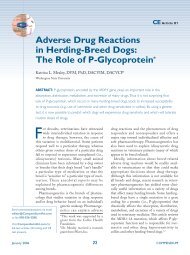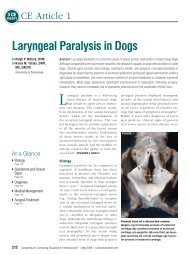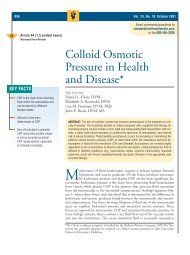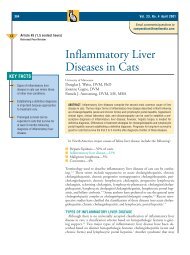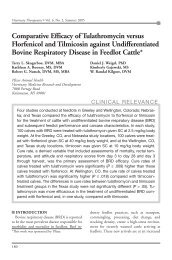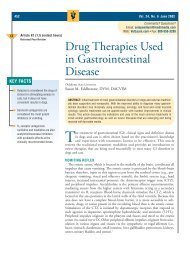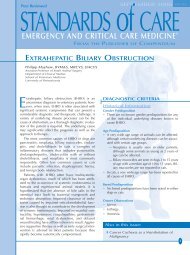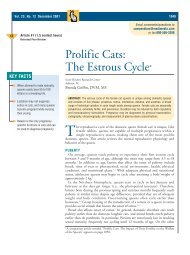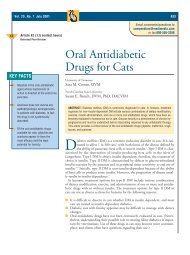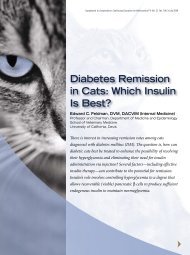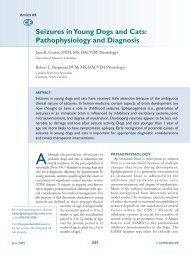Cryptosporidium Infections in Cats and Dogs - VetLearn.com
Cryptosporidium Infections in Cats and Dogs - VetLearn.com
Cryptosporidium Infections in Cats and Dogs - VetLearn.com
Create successful ePaper yourself
Turn your PDF publications into a flip-book with our unique Google optimized e-Paper software.
Article #3<br />
CE<br />
ABSTRACT:<br />
Cryptosporidiosis was recognized as an important zoonosis <strong>in</strong> the early 1980s. Early<br />
studies assumed that all <strong>in</strong>fections <strong>in</strong> mammals, <strong>in</strong>clud<strong>in</strong>g humans, were caused by the<br />
parasite <strong>Cryptosporidium</strong> parvum. Recent studies us<strong>in</strong>g molecular biologic tools <strong>and</strong> hostspecificity<br />
studies <strong>in</strong>dicate that cats <strong>and</strong> dogs have their own unique species of <strong>Cryptosporidium</strong><br />
(C. felis <strong>and</strong> C. canis, respectively). Surveys <strong>in</strong>dicate that up to 38.5% of cats <strong>and</strong><br />
up to 44.8% of dogs are <strong>in</strong>fected with <strong>Cryptosporidium</strong> spp. Initial studies <strong>in</strong>dicate that<br />
own<strong>in</strong>g a cat or dog does not <strong>in</strong>crease the risk of humans acquir<strong>in</strong>g cryptosporidiosis,<br />
although human <strong>in</strong>fections with C. felis <strong>and</strong> C. canis have been found <strong>in</strong> patients with<br />
AIDS, immunosuppressed patients, <strong>and</strong> children from impoverished areas. Cl<strong>in</strong>ical signs<br />
of cryptosporidiosis <strong>in</strong> cats <strong>and</strong> dogs vary from none to chronic or <strong>in</strong>termittent diarrhea.<br />
Fluids <strong>and</strong> other supportive measures should be used <strong>in</strong> animals with diarrhea, but<br />
there is no proven safe <strong>and</strong> effective treatment of cryptosporidiosis.<br />
embers of the genus <strong>Cryptosporidium</strong><br />
are <strong>in</strong> the protozoan phylum Api<strong>com</strong>plexa.<br />
They are coccidia-like parasites<br />
that develop <strong>in</strong> the microvillous border of<br />
epithelial cells <strong>in</strong> the digestive, respiratory, <strong>and</strong><br />
ur<strong>in</strong>ary tracts of vertebrates. 1 Recent molecular<br />
phylogenetic studies <strong>in</strong>dicate that cryptosporidia<br />
are more closely related to the gregar<strong>in</strong>e<br />
parasites of <strong>in</strong>vertebrates than to the true coccidial<br />
parasites of vertebrates. 2 This may expla<strong>in</strong><br />
why cryptosporidia are not sensitive to chemotherapeutic<br />
agents normally used to treat coccidial<br />
<strong>in</strong>fections. 1 M<br />
In the early 1980s, <strong>Cryptosporidium</strong><br />
parvum was identified as a major<br />
cause of <strong>in</strong>test<strong>in</strong>al disease <strong>in</strong> patients with<br />
Email <strong>com</strong>ments/questions to<br />
<strong>com</strong>pendium@medimedia.<strong>com</strong>,<br />
fax 800-556-3288, or log on to<br />
www.<strong>VetLearn</strong>.<strong>com</strong><br />
<strong>Cryptosporidium</strong> <strong>Infections</strong><br />
<strong>in</strong> <strong>Cats</strong> <strong>and</strong> <strong>Dogs</strong><br />
David S. L<strong>in</strong>dsay, PhD a<br />
Anne M. Zajac, DVM, PhD<br />
Virg<strong>in</strong>ia-Maryl<strong>and</strong> Regional College of Veter<strong>in</strong>ary Medic<strong>in</strong>e<br />
a Dr. L<strong>in</strong>dsay receives fund<strong>in</strong>g<br />
from Bayer Animal Health <strong>and</strong><br />
Merck & Company. Neither<br />
<strong>com</strong>pany has been <strong>in</strong>volved <strong>in</strong><br />
the preparation of this article.<br />
AIDS, <strong>and</strong> it was later found <strong>in</strong> immuno<strong>com</strong>petent<br />
humans who had been exposed to<br />
<strong>in</strong>fected dairy calves. 3 Several groups of<br />
researchers conducted studies <strong>in</strong> which C.<br />
parvum was successfully transmitted from<br />
calves to young animals, <strong>in</strong>clud<strong>in</strong>g cats <strong>and</strong><br />
dogs. 1,3 Successful cross-species transmission<br />
studies with C. parvum led to the proposal that<br />
the organism was responsible for all <strong>in</strong>fections<br />
<strong>in</strong> mammals. 4 Most parasitologists embraced<br />
this concept, which has been taught <strong>in</strong> most<br />
veter<strong>in</strong>ary schools s<strong>in</strong>ce the 1980s. Recent studies<br />
of <strong>Cryptosporidium</strong> spp from cats, 5–10<br />
dogs, 11–13 <strong>and</strong> humans 14 <strong>in</strong>dicate that these<br />
organisms are biologically <strong>and</strong> genetically different<br />
from C. parvum; thus they are now considered<br />
separate species. <strong>Cryptosporidium</strong> felis is<br />
primarily found <strong>in</strong> cats 5 <strong>and</strong> <strong>Cryptosporidium</strong><br />
canis <strong>in</strong> dogs 11 ; <strong>Cryptosporidium</strong> hom<strong>in</strong>is is the<br />
newly recognized parasite <strong>in</strong> humans. 14<br />
COMPENDIUM 864 November 2004
Ingestion<br />
Excystation<br />
Thick-walled<br />
oocyst<br />
Exits body<br />
Sporozoite<br />
Host<br />
Excystation epithelial<br />
cell<br />
Auto<strong>in</strong>fection<br />
Th<strong>in</strong>-walled oocyst<br />
Mature<br />
oocyst<br />
Trophozoite<br />
Immature<br />
oocyst<br />
LIFE CYCLE<br />
Sporulated oocysts are <strong>in</strong>gested via direct contact with<br />
the feces of an <strong>in</strong>fected host or contam<strong>in</strong>ated food or<br />
water (Figure 1). The oocysts excyst <strong>in</strong> the digestive<br />
tract, <strong>and</strong> the sporozoites penetrate the microvilli of a<br />
variety of epithelial cells. The location of the <strong>in</strong>fected<br />
host cells depends on the species of <strong>Cryptosporidium</strong>. The<br />
elongated sporozoite rounds up <strong>and</strong> be<strong>com</strong>es a trophozoite.<br />
The trophozoite be<strong>com</strong>es a mult<strong>in</strong>ucleated type I<br />
schizont <strong>and</strong> produces eight type I merozoites, which<br />
penetrate other microvilli <strong>and</strong> be<strong>com</strong>e type II schizonts.<br />
Type II schizonts repeat this developmental cycle, result<strong>in</strong>g<br />
<strong>in</strong> four type II merozoites. Recycl<strong>in</strong>g of asexual<br />
stages may occur. Type II merozoites penetrate microvilli<br />
<strong>and</strong> be<strong>com</strong>e sexual stages. The male stage (i.e., microga-<br />
<strong>Cryptosporidium</strong> <strong>Infections</strong> <strong>in</strong> <strong>Cats</strong> <strong>and</strong> <strong>Dogs</strong> CE 865<br />
Microgamont<br />
Macrogamont<br />
Type I meront<br />
Merozoite<br />
Merozoite<br />
Type II meront<br />
Figure 1. Life cycle of <strong>Cryptosporidium</strong> spp. (Adapted from Dubey JP, Speer CA, Fayer R: Cryptosporidiosis of Man <strong>and</strong> Animals. Boca Raton, FL,<br />
CRC Press, 1990)<br />
mont) produces nonflagellated microgametes. In the<br />
female stage (i.e., macrogamont), fertilization occurs <strong>and</strong><br />
oocysts are produced. Two types of oocysts are produced,<br />
both of which sporulate endogenously <strong>and</strong> conta<strong>in</strong> four<br />
sporozoites, an oocyst residuum, <strong>and</strong> no sporocysts.<br />
Th<strong>in</strong>-walled oocysts are auto<strong>in</strong>fective. Thick-walled<br />
oocysts are excreted <strong>in</strong> the feces. 5,11,14<br />
<strong>Cryptosporidium</strong> spp conta<strong>in</strong> approximately 5,000<br />
members, <strong>in</strong>clud<strong>in</strong>g Plasmodium (malaria), Toxoplasma,<br />
Babesia, Neospora, Sarcocystis, <strong>and</strong> Eimeria spp. Most are<br />
obligate <strong>in</strong>tracellular parasites. Api<strong>com</strong>plexans lack<br />
appendages for lo<strong>com</strong>otion <strong>and</strong> <strong>in</strong>stead move by a “glid<strong>in</strong>g”<br />
motion. Cell entry by this group is mechanically<br />
dist<strong>in</strong>ct from uptake of viruses, bacteria, <strong>and</strong> other parasites.<br />
<strong>Cryptosporidium</strong>, Eimeria, <strong>and</strong> Toxoplasma spp<br />
November 2004 COMPENDIUM
866 CE<br />
<strong>Cryptosporidium</strong> <strong>Infections</strong> <strong>in</strong> <strong>Cats</strong> <strong>and</strong> <strong>Dogs</strong><br />
form oocysts that are shed <strong>in</strong> the feces of <strong>in</strong>fected hosts.<br />
Cryptosporidia oocysts are very resistant to environmental<br />
damage, chlor<strong>in</strong>ation, <strong>and</strong> st<strong>and</strong>ard cleansers.<br />
This makes <strong>Cryptosporidium</strong> spp an important food<strong>and</strong><br />
waterborne pathogen. Extreme temperatures <strong>and</strong><br />
prolonged contact with ammonia destroy the oocysts.<br />
PATHOGENESIS<br />
The mechanisms by which <strong>Cryptosporidium</strong> spp<br />
<strong>in</strong>duce diarrhea, malabsorption, <strong>and</strong> wast<strong>in</strong>g <strong>in</strong> humans<br />
<strong>and</strong> animals are not well understood. 15 Cryptosporidial<br />
parasites can develop <strong>in</strong> a variety of epithelial cells <strong>in</strong> the<br />
body, not just <strong>in</strong> enterocytes <strong>in</strong> the <strong>in</strong>test<strong>in</strong>es. This can<br />
lead to respiratory, ocular, pancreatic, <strong>and</strong> hepatic <strong>in</strong>fections<br />
<strong>in</strong> humans; fortunately, these extra<strong>in</strong>test<strong>in</strong>al loci of<br />
cryptosporidial <strong>in</strong>fection have not been reported <strong>in</strong> dogs<br />
or cats. Cryptosporidia develop <strong>in</strong> the microvillous border<br />
<strong>and</strong> displace it, eventually lead<strong>in</strong>g to loss of mature<br />
<strong>Dogs</strong><br />
Most reported cases of cryptosporidiosis <strong>in</strong> dogs <strong>in</strong>volve<br />
young animals. 13,28–33 Cases <strong>in</strong> adult dogs are rare. 34<br />
Cl<strong>in</strong>ical signs can vary from none to chronic or <strong>in</strong>termittent<br />
diarrhea <strong>and</strong> wast<strong>in</strong>g. Immunosuppression due<br />
to can<strong>in</strong>e distemper may exacerbate <strong>in</strong>fections <strong>in</strong><br />
dogs. 29,31 Concurrent can<strong>in</strong>e parvovirus <strong>in</strong>fection <strong>and</strong><br />
<strong>in</strong>test<strong>in</strong>al Isospora spp <strong>in</strong>fection may also enhance cryptosporidiosis<br />
<strong>in</strong> immunosuppressed dogs. 13,32 Two recent<br />
reports used molecular methods to determ<strong>in</strong>e the <strong>Cryptosporidium</strong><br />
spp <strong>in</strong> a fatal case <strong>in</strong>volv<strong>in</strong>g an 8-week-old<br />
Yorkshire terrier from Georgia 33 <strong>and</strong> a nonfatal case <strong>in</strong>volv<strong>in</strong>g<br />
a 9-week-old bullmastiff from Australia, 13 <strong>and</strong><br />
both reports found that C. canis organisms were present.<br />
DIAGNOSIS<br />
The small size of <strong>Cryptosporidium</strong> oocysts makes them<br />
difficult to detect. Oocysts are often overlooked unless<br />
Oocysts of C. felis <strong>and</strong> C. canis are structurally similar<br />
to the well-known <strong>and</strong> zoonotic C. parvum.<br />
surface epithelium. 15 This causes shorten<strong>in</strong>g <strong>and</strong> fusion<br />
of villi <strong>and</strong> lengthen<strong>in</strong>g of the crypts due to acceleration<br />
of cell division to <strong>com</strong>pensate for loss of cells. 15 This<br />
causes reduced uptake of fluids, electrolytes, <strong>and</strong> nutrients<br />
from the gut lumen. 15<br />
The m<strong>in</strong>imum <strong>in</strong>fective dose of <strong>Cryptosporidium</strong> oocysts<br />
for cats <strong>and</strong> dogs is unknown. Experimental studies <strong>in</strong><br />
humans us<strong>in</strong>g C. parvum oocysts collected from calves<br />
<strong>in</strong>dicate that 10 or fewer oocysts can cause <strong>in</strong>fection. 16<br />
Differences <strong>in</strong> <strong>in</strong>fectivity among different C. parvum isolates<br />
<strong>in</strong> human volunteers have been documented. 15<br />
CLINICAL SIGNS<br />
<strong>Cats</strong><br />
Most cats that are excret<strong>in</strong>g <strong>Cryptosporidium</strong> oocysts<br />
do not have cl<strong>in</strong>ical signs. 5,7,17–20 Young 17,18 or immuno<strong>com</strong>promised<br />
18,21 animals are more likely to be <strong>in</strong>fected.<br />
Chronic or <strong>in</strong>termittent diarrhea, anorexia, <strong>and</strong> wast<strong>in</strong>g<br />
are <strong>com</strong>mon cl<strong>in</strong>ical signs <strong>in</strong> symptomatic cats. 21–25<br />
Co<strong>in</strong>fection with Giardia spp or Tritrichomonas foetus<br />
may exacerbate cl<strong>in</strong>ical signs of cryptosporidiosis <strong>in</strong><br />
cats. 26,27 Adm<strong>in</strong>ister<strong>in</strong>g prednisolone (10 mg/kg/day SC<br />
for 4 to 9 days 7 or 2.8 to 3.8 mg/kg/day PO for 26<br />
days 27 ) may cause oocysts to reappear <strong>in</strong> fel<strong>in</strong>e feces.<br />
an exam<strong>in</strong>er is specifically look<strong>in</strong>g for them, <strong>and</strong> this is<br />
especially true if few oocysts are present <strong>in</strong> the sample.<br />
Fecal flotation techniques used rout<strong>in</strong>ely <strong>in</strong> veter<strong>in</strong>ary<br />
laboratories are adequate to demonstrate <strong>Cryptosporidium</strong><br />
oocysts if large numbers are present. The slide<br />
should be exam<strong>in</strong>ed us<strong>in</strong>g the high-power objective.<br />
Sheather’s sugar solution is the best flotation medium. 3<br />
Because oocysts are small, they float <strong>in</strong> a plane higher<br />
than that of helm<strong>in</strong>th ova <strong>and</strong> other protozoal cysts.<br />
They are light p<strong>in</strong>k, <strong>and</strong> a central residual body is usually<br />
visible <strong>in</strong> <strong>Cryptosporidium</strong> oocysts <strong>in</strong> fecal flotations.<br />
C. felis oocysts are smaller 9,17,35 than those of C. parvum,<br />
but morphology alone cannot be used to determ<strong>in</strong>e the<br />
species of <strong>Cryptosporidium</strong> <strong>in</strong> a sample. 36 Many small<br />
animal technicians are not taught to recognize <strong>Cryptosporidium</strong><br />
oocysts <strong>and</strong> may have difficulty identify<strong>in</strong>g<br />
them when the tests are run only <strong>in</strong>frequently. In these<br />
cases, it is probably better for samples to be sent to diagnostic<br />
reference laboratories for test<strong>in</strong>g.<br />
Fecal samples sent to diagnostic laboratories can be<br />
tested us<strong>in</strong>g a number of procedures. 37 More than 10 different<br />
types of sta<strong>in</strong><strong>in</strong>g methods have been developed for<br />
use with fecal smears to aid <strong>in</strong> detect<strong>in</strong>g <strong>Cryptosporidium</strong><br />
oocysts via st<strong>and</strong>ard light microscopy. 37 The Ziehl-Neelsen<br />
COMPENDIUM November 2004
868 CE<br />
<strong>Cryptosporidium</strong> <strong>Infections</strong> <strong>in</strong> <strong>Cats</strong> <strong>and</strong> <strong>Dogs</strong><br />
Table 1. Transmission Studies with C. felis <strong>and</strong><br />
C. canis Oocysts<br />
Source Recipient Results Study<br />
Cat Gu<strong>in</strong>ea pigs Negative Iseki 5 , Arai et al 17<br />
Cat Mice Negative Iseki 5 , Arai et al 17<br />
Cat Newborn mice Negative Mtambo et al 8 ,<br />
Arai et al 17<br />
Cat Lambs Positive Mtambo et al 8<br />
Cat Immunosuppressed mice Negative Mtambo et al 8<br />
Cat Rats Negative Arai et al 17<br />
Cat <strong>Dogs</strong> Negative Arai et al 17<br />
Dog Newborn mice Negative Fayer et al 11<br />
Dog Immunosuppressed mice Negative Fayer et al 11<br />
Dog Calves Positive Fayer et al 11<br />
Table 2. Prevalence of <strong>Cryptosporidium</strong> spp <strong>in</strong> <strong>Cats</strong><br />
Number Prevalence<br />
Exam<strong>in</strong>ed Location Test (%) Study<br />
600 United States Serology 8.3 McReynolds et al 50<br />
418 Australia Fecal 0 McGlade et al 52<br />
40 Australia PCR 10 McGlade et al 52<br />
102 Australia Fecal 1.2 Sargent et al 9<br />
10 France Fecal 0 Chermette <strong>and</strong><br />
Blondel 53<br />
300 Germany Fecal 1.3 August<strong>in</strong>-Bichl 55<br />
13 Japan Fecal 38.5 Iseki 5<br />
507 Japan Fecal 20 Uga et al 54<br />
608 Japan Fecal 3.8 Arai et al 17<br />
57 Scotl<strong>and</strong> Fecal 12.3 Nash et al 19<br />
235 Scotl<strong>and</strong> Fecal 8.1 Mtambo et al 18<br />
205 Colorado Fecal 5.4 Hill et al 51<br />
263 New York Fecal 3.8 Spa<strong>in</strong> et al 20<br />
acid-fast sta<strong>in</strong><strong>in</strong>g technique is most often used <strong>and</strong> produces red-sta<strong>in</strong>ed oocysts<br />
aga<strong>in</strong>st a blue–green background of fecal material. Fluorescently labeled monoclonal<br />
antibodies to the oocyst stage of C. parvum have been made <strong>and</strong> are used<br />
<strong>in</strong> a <strong>com</strong>mercial direct immunofluorescent antibody (IFA) test. 38 Most <strong>Cryptosporidium</strong><br />
spp, <strong>in</strong>clud<strong>in</strong>g C. felis <strong>and</strong> C. canis, cross-react <strong>in</strong> <strong>com</strong>mercial IFAbased<br />
diagnostic tests developed to detect C. parvum. 39,40 Cross-reactivity also<br />
occurs <strong>in</strong> many ELISAs for C. parvum. 38 Polymerase cha<strong>in</strong> reaction (PCR) can<br />
detect <strong>Cryptosporidium</strong> spp <strong>in</strong> fecal samples, <strong>and</strong> PCR is more sensitive than<br />
IFA test<strong>in</strong>g. 41 Most PCR-based tests <strong>in</strong>dicate only the presence of <strong>Cryptosporidium</strong><br />
spp, but a recently developed set of PCR tests can differentiate between C.<br />
felis, C. canis, C. parvum, <strong>and</strong> C. hom<strong>in</strong>is. 42<br />
COMPENDIUM November 2004
TREATMENT<br />
Chemotherapy for <strong>Cryptosporidium</strong><br />
<strong>in</strong>fections <strong>in</strong> animals <strong>and</strong> humans has<br />
been actively <strong>in</strong>vestigated over the past<br />
two decades (see box on page 871).<br />
Over 100 <strong>com</strong>pounds have been tested<br />
<strong>in</strong> laboratory animal models, but none<br />
is highly effective cl<strong>in</strong>ically. 43 Paromomyc<strong>in</strong><br />
44 <strong>and</strong> nitazoxanide (NTZ) 27<br />
are <strong>com</strong>pounds that have shown some<br />
efficacy <strong>in</strong> animal models <strong>and</strong> have<br />
also been used to treat <strong>in</strong>test<strong>in</strong>al cryptosporidiosis<br />
<strong>in</strong> cats. Treatment with<br />
paromomyc<strong>in</strong> (165 mg/kg PO bid for<br />
5 days) resulted <strong>in</strong> resolution of diarrhea<br />
<strong>and</strong> disappearance of oocysts<br />
from the feces of a 6-month-old cat<br />
with persistent diarrhea. 44 Paromomyc<strong>in</strong><br />
is potentially nephrotoxic,<br />
<strong>and</strong> acute renal failure was reported <strong>in</strong><br />
four cats that received paromomyc<strong>in</strong><br />
for cryptosporidiosis or trichomoniasis.<br />
45 Treatment us<strong>in</strong>g NTZ (25 mg/kg<br />
PO bid for 28 days) elim<strong>in</strong>ated <strong>Cryptosporidium</strong><br />
oocysts from the feces of<br />
naturally <strong>in</strong>fected laboratory cats. Use<br />
of NTZ was associated with vomit<strong>in</strong>g<br />
<strong>and</strong> the presence of dark brown–black, foul-smell<strong>in</strong>g<br />
diarrhea while treat<strong>in</strong>g these cats. 27 Chlorpromaz<strong>in</strong>e (0.5<br />
to 1.5 mg SC once daily) was given to alleviate vomit<strong>in</strong>g<br />
<strong>in</strong> NTZ-treated cats. 27 Fenbendazole adm<strong>in</strong>istered at 50<br />
mg/kg PO for 5 days did not affect <strong>Cryptosporidium</strong><br />
oocyst excretion <strong>in</strong> cats. 26<br />
Treatment of an 18-month-old cat with <strong>in</strong>flammatory<br />
bowel disease <strong>and</strong> <strong>Cryptosporidium</strong> <strong>in</strong>fection was successful<br />
us<strong>in</strong>g a course of cl<strong>in</strong>damyc<strong>in</strong> (25 mg/kg/day<br />
[three-fourths of the total dose was adm<strong>in</strong>istered <strong>in</strong> the<br />
morn<strong>in</strong>g <strong>and</strong> one-fourth of the total dose at night] PO<br />
for 60 days) <strong>and</strong> then tylos<strong>in</strong> (11 mg/kg PO bid with<br />
food for 28 days). 15 Interpretation of these results was<br />
hampered because of the presence of Clostridium perfr<strong>in</strong>gens<br />
<strong>in</strong> the cat’s <strong>in</strong>test<strong>in</strong>al tract. Cl<strong>in</strong>damyc<strong>in</strong> adm<strong>in</strong>istered<br />
at 15 mg/kg PO q8h for 6 days did not elim<strong>in</strong>ate<br />
<strong>Cryptosporidium</strong> oocysts from a 5-year-old po<strong>in</strong>ter. 34<br />
STUDIES ON HOST SPECIFICITY OF<br />
C. FELIS AND C. CANIS<br />
Transmission studies with C. felis <strong>and</strong> C. canis <strong>in</strong>dicate<br />
that these species are relatively host-specific (Table 1).<br />
<strong>Cryptosporidium</strong> <strong>Infections</strong> <strong>in</strong> <strong>Cats</strong> <strong>and</strong> <strong>Dogs</strong> CE 869<br />
Table 3. Prevalence of <strong>Cryptosporidium</strong> spp <strong>in</strong> <strong>Dogs</strong><br />
Number Prevalence<br />
Exam<strong>in</strong>ed Location Test (%) Study<br />
421 Australia Fecal/PCR 0 Bugg et al 62<br />
493 Australia Fecal 11 Johnston <strong>and</strong> Gasser 65<br />
195 Australia Fecal 7.1 Milste<strong>in</strong> <strong>and</strong><br />
Goldsmith 66<br />
25 Egypt Fecal 12 El-Hohary <strong>and</strong><br />
Abdel-Latif 67<br />
57 F<strong>in</strong>l<strong>and</strong> Fecal 0 Pohjola 68<br />
29 France Fecal 44.8 Chermette <strong>and</strong><br />
Blondel 53<br />
200 Germany Fecal 0 August<strong>in</strong>-Bichl et al 55<br />
213 Japan Fecal 1.4 Uga et al 54<br />
140 Japan PCR 9.3 Abe et al 63<br />
257 Korea Fecal 9.7 Kim et al 40<br />
81 Spa<strong>in</strong> Fecal 7.4 Causape et al 61<br />
101 Scotl<strong>and</strong> Fecal 0 Simpson et al 59<br />
100 Scotl<strong>and</strong> Fecal 1 Grimason et al 69<br />
200 California Fecal 2 el-Ahraf et al 60<br />
130 Colorado Fecal 3.8 Hackett <strong>and</strong> Lapp<strong>in</strong> 64<br />
49 Georgia Fecal 10.2 Jafri et al 70<br />
100 Kentucky Fecal 17 Juett et al 71<br />
However, additional well-controlled PCR-based <strong>and</strong><br />
PCR species–validated transmission studies need to be<br />
conducted before these earlier observations can be <strong>com</strong>pletely<br />
accepted. C. felis was not <strong>in</strong>fectious <strong>in</strong> dogs or laboratory<br />
rodents <strong>in</strong> a limited number of studies. It is <strong>in</strong>fectious<br />
<strong>in</strong> lambs 8 <strong>and</strong> has been found <strong>in</strong> a naturally <strong>in</strong>fected<br />
cow. 35 C. canis is not <strong>in</strong>fectious <strong>in</strong> laboratory rodents but<br />
is mildly <strong>in</strong>fectious <strong>in</strong> calves. 11 The <strong>in</strong>fectivity of C. canis<br />
oocysts <strong>in</strong> cats has not been exam<strong>in</strong>ed. C. parvum oocysts<br />
are moderately <strong>in</strong>fectious <strong>in</strong> cats <strong>and</strong> dogs. 3,11 Molecularly<br />
confirmed natural cases of C. parvum or C. hom<strong>in</strong>is have<br />
not been reported <strong>in</strong> cats or dogs.<br />
Several studies have suggested that humans have been<br />
<strong>in</strong>fected with <strong>Cryptosporidium</strong> spp from kittens or<br />
cats. 46–48 None of these studies conducted genotyp<strong>in</strong>g or<br />
other studies, <strong>and</strong> they should be viewed as only circumstantially<br />
<strong>in</strong>crim<strong>in</strong>at<strong>in</strong>g cats <strong>in</strong> the transmission of<br />
<strong>Cryptosporidium</strong> spp to humans.<br />
One study <strong>in</strong>dicated that a veter<strong>in</strong>ary student car<strong>in</strong>g<br />
for an adult dog with cryptosporidiosis developed cryptosporidiosis.<br />
34 The parasite <strong>in</strong> the dog or the veter<strong>in</strong>ary<br />
student was not genotyped or further characterized.<br />
November 2004 COMPENDIUM
870 CE<br />
<strong>Cryptosporidium</strong> <strong>Infections</strong> <strong>in</strong> <strong>Cats</strong> <strong>and</strong> <strong>Dogs</strong><br />
Table 4. Reports of C. felis, C. canis, C. parvum, <strong>and</strong> C. hom<strong>in</strong>is<br />
<strong>in</strong> Humans Who Tested Positive for Oocysts a<br />
Number <strong>and</strong> Type<br />
Percentage with<br />
of Patients C. felis C. canis C. parvum C. hom<strong>in</strong>is Study<br />
30 with HIV 30% 10% 10% 50% Pieniazek et al 72<br />
22 with HIV 27% 0% 32% 9% Morgan et al 73<br />
1 with HIV 100% NA NA NA Caccio et al 74<br />
34 with HIV 9% 6% 15% 50% Gatei et al 75<br />
25 with HIV 4% 0% 56% 32% Alves et al 76<br />
80 children b 1% 3% 10% 84% Xiao et al 77<br />
1,680 (mixed)
On the Horizon a<br />
The genome sequence for C. parvum has recently been<br />
generated. C. parvum lacks many typical metabolic<br />
pathways, <strong>in</strong>clud<strong>in</strong>g Krebs cycle <strong>and</strong> de novo synthesis<br />
of am<strong>in</strong>o acids <strong>and</strong> nucleotides. In addition,<br />
<strong>Cryptosporidium</strong> spp conta<strong>in</strong> many plant-like enzymes<br />
that are absent or very different from those usually found<br />
<strong>in</strong> mammals. Further analysis of this genome could<br />
provide important clues <strong>in</strong> develop<strong>in</strong>g an effective drug<br />
aga<strong>in</strong>st this parasite.<br />
a Abrahamsen et al: Science 304:441, 2004.<br />
mans, 72–76 children, 77 or humans with cryptosporidiosis<br />
<strong>and</strong> some underly<strong>in</strong>g immunosuppressive conditions 78–87<br />
(Table 4). The prevalence of C. felis <strong>and</strong> C. canis <strong>in</strong> humans<br />
is less than that of C. hom<strong>in</strong>is <strong>and</strong> C. parvum. Some<br />
studies have not found C. felis or C. canis <strong>in</strong> humans.<br />
PREVALENCE OF CRYPTOSPORIDIUM<br />
SPECIES IN THE ENVIRONMENT<br />
<strong>Cryptosporidium</strong> oocysts are <strong>com</strong>mon <strong>in</strong> the environment<br />
<strong>and</strong> have been found <strong>in</strong> surveys of nondr<strong>in</strong>k<strong>in</strong>g<br />
surface <strong>and</strong> waste waters. 88–91 However, genotyp<strong>in</strong>g<br />
<strong>Cryptosporidium</strong> isolates from nondr<strong>in</strong>k<strong>in</strong>g water sources<br />
<strong>in</strong>dicates little contam<strong>in</strong>ation by C. felis or C. canis. 90<br />
One study documented C. felis or C. canis oocysts <strong>in</strong> raw<br />
waste water but found none <strong>in</strong> raw surface water. 90<br />
Although major outbreaks of human cryptosporidiosis<br />
have been l<strong>in</strong>ked to contam<strong>in</strong>ated dr<strong>in</strong>k<strong>in</strong>g water, 92–95<br />
molecular studies <strong>in</strong>dicate that C. hom<strong>in</strong>is 96–98 <strong>and</strong> C.<br />
parvum 96,98 have been responsible for dr<strong>in</strong>k<strong>in</strong>g water–<br />
associated outbreaks of human cryptosporidiosis. No<br />
reports <strong>in</strong>dicate that C. felis or C. canis has been associated<br />
with waterborne outbreaks of human disease.<br />
CONCLUSION<br />
Despite extensive experimental <strong>and</strong> epidemiologic literature<br />
on <strong>Cryptosporidium</strong> spp, the primary species<br />
<strong>in</strong>fect<strong>in</strong>g dogs <strong>and</strong> cats, C. canis <strong>and</strong> C. felis, respectively,<br />
have been identified only recently, <strong>and</strong> there is little<br />
experimental work document<strong>in</strong>g their pathogenicity or<br />
<strong>Cryptosporidium</strong> <strong>Infections</strong> <strong>in</strong> <strong>Cats</strong> <strong>and</strong> <strong>Dogs</strong> CE 871<br />
Resources<br />
avma.org/noah/resources/zoonosis/crypto.asp<br />
(password protected)<br />
The AVMA Network of Animal Health provides<br />
zoonosis updates.<br />
v<strong>in</strong>.<strong>com</strong> (password protected)<br />
Search “cryptosporidiosis” photographs: Kirsten Vance’s<br />
Arthropod <strong>and</strong> Protozoa slide show<br />
L<strong>in</strong>dsay D: Proc West Vet Conf: Giardia <strong>and</strong><br />
Cryptosporidia: Really Zoonotic<br />
zoonotic potential. The contribution of can<strong>in</strong>e <strong>and</strong><br />
fel<strong>in</strong>e <strong>Cryptosporidium</strong> spp to cl<strong>in</strong>ical disease <strong>in</strong> pets<br />
does not seem to be great at this time but may be underestimated<br />
because so few cats <strong>and</strong> dogs are tested for<br />
<strong>in</strong>fection. In contrast, the risk of zoonotic <strong>in</strong>fection has<br />
received considerably more attention. Many practic<strong>in</strong>g<br />
veter<strong>in</strong>arians are unaware that, to m<strong>in</strong>imize exposure to<br />
<strong>Cryptosporidium</strong> spp, current guidel<strong>in</strong>es from the US<br />
Public Health Service <strong>and</strong> Infectious Diseases Society<br />
of America re<strong>com</strong>mend that HIV-<strong>in</strong>fected humans<br />
should not take <strong>in</strong>to their homes stray dogs or cats, animals<br />
with diarrhea, or dogs <strong>and</strong> cats younger than 6<br />
months of age. 99 They further re<strong>com</strong>mend that if a dog<br />
Cl<strong>in</strong>ical signs of <strong>Cryptosporidium</strong> <strong>in</strong>fection <strong>in</strong> cats <strong>and</strong> dogs<br />
vary from none to chronic or <strong>in</strong>termittent diarrhea.<br />
or cat younger than 6 months of age is acquired by an<br />
HIV-<strong>in</strong>fected person, the animal should be tested for<br />
<strong>Cryptosporidium</strong> spp. These re<strong>com</strong>mendations, dat<strong>in</strong>g<br />
from 1999, may be more str<strong>in</strong>gent than necessary, but<br />
further molecular analysis of human <strong>and</strong> animal <strong>in</strong>fections<br />
is needed to realistically assess potential transmission<br />
from pets to humans. Until more is known, practitioners<br />
should recognize that <strong>Cryptosporidium</strong> <strong>in</strong>fection<br />
<strong>in</strong> dogs <strong>and</strong> cats is not un<strong>com</strong>mon <strong>in</strong> North America<br />
<strong>and</strong> that zoonotic transmission from pets could cause<br />
serious disease <strong>in</strong> immuno<strong>com</strong>promised humans.<br />
REFERENCES<br />
1. Fayer R, Ungar BL: <strong>Cryptosporidium</strong> spp <strong>and</strong> cryptosporidiosis. Microbiol Rev<br />
50:458–483, 1986.<br />
2. Carreno RA, Mart<strong>in</strong> DS, Barta JR: <strong>Cryptosporidium</strong> is more closely related to<br />
the gregar<strong>in</strong>es than to coccidia as shown by phylogenetic analysis of api<strong>com</strong>-<br />
November 2004 COMPENDIUM
872 CE<br />
<strong>Cryptosporidium</strong> <strong>Infections</strong> <strong>in</strong> <strong>Cats</strong> <strong>and</strong> <strong>Dogs</strong><br />
plexan parasites <strong>in</strong>ferred us<strong>in</strong>g small-subunit ribosomal RNA gene sequences.<br />
Parasitol Res 85:899–904, 1999.<br />
3. Current WL, Reese NC, Ernst JV, et al: Human cryptosporidiosis <strong>in</strong><br />
immuno<strong>com</strong>petent <strong>and</strong> immunodeficient persons. Studies of an outbreak <strong>and</strong><br />
experimental transmission. N Engl J Med 308:1252–1257, 1983.<br />
4. Tzipori S, Angus KW, Campbell I, Gray EW: <strong>Cryptosporidium</strong>: Evidence for<br />
a s<strong>in</strong>gle-species genus. Infect Immunol 30:884–886, 1980.<br />
5. Iseki M: <strong>Cryptosporidium</strong> felis sp. N. (Protozoa: Eimerior<strong>in</strong>a) from the<br />
domestic cat. Jpn J Parasitol 28:285–307, 1979.<br />
6. Morgan UM, Monis PT, Fayer R, et al: Phylogenetic relationships among<br />
isolates of <strong>Cryptosporidium</strong>: Evidence for several new species. J Parasitol<br />
85:1126–1133, 1999.<br />
7. Asahi H, Koyama T, Arai H, et al: Biological nature of <strong>Cryptosporidium</strong> sp.<br />
isolated from a cat. Parasitol Res 77:237–240, 1991.<br />
8. Mtambo MM, Wright E, Nash AS, Blewett DA: Infectivity of a <strong>Cryptosporidium</strong><br />
species isolated from a domestic cat (Felis domestica) <strong>in</strong> lambs <strong>and</strong><br />
mice. Res Vet Sci 60:61–64, 1996.<br />
9. Sargent KD, Morgan UM, Elliot A, Thompson RC: Morphological <strong>and</strong><br />
genetic characterisation of <strong>Cryptosporidium</strong> oocysts from domestic cats. Vet<br />
Parasitol 77:221–227, 1998.<br />
10. Morgan UM, Sargent KD, Elliot A, Thompson RC: <strong>Cryptosporidium</strong> <strong>in</strong> cats:<br />
Additional evidence for C. felis. Vet J 156:159–161, 1998.<br />
11. Fayer R, Trout JM, Xiao L, et al: <strong>Cryptosporidium</strong> canis n. sp. from domestic<br />
dogs. J Parasitol 87:1415–1422, 2001.<br />
12. Morgan UM, Xiao L, Monis P, et al: <strong>Cryptosporidium</strong> spp. <strong>in</strong> domestic dogs:<br />
The “dog” genotype. Appl Environ Microbiol 66:2220–2223, 2000.<br />
13. Denholm KM, Haitjema H, Gwynne BJ, et al: Concurrent <strong>Cryptosporidium</strong><br />
<strong>and</strong> parvovirus <strong>in</strong>fections <strong>in</strong> a puppy. Aust Vet J 79:98–101, 2001.<br />
14. Morgan-Ryan UM, Fall A, Ward LA, et al: <strong>Cryptosporidium</strong> hom<strong>in</strong>is n. sp.<br />
(Api<strong>com</strong>plexa: Cryptosporidiidae) from Homo sapiens. J Eukaryot Microbiol<br />
49:433–440, 2002.<br />
15. Tzipori S, Ward H: Cryptosporidiosis: Biology, pathogenesis <strong>and</strong> disease.<br />
Microbes Infect 4:1047–1058, 2002.<br />
16. Okhuysen PC, Chappell CL, Crabb JH, et al: Virulence of three dist<strong>in</strong>ct<br />
<strong>Cryptosporidium</strong> parvum isolates for healthy adults. J Infect Dis<br />
180:1275–1281, 1999.<br />
17. Arai H, Fukuda Y, Hara T, et al: Prevalence of <strong>Cryptosporidium</strong> <strong>in</strong>fection<br />
among domestic cats <strong>in</strong> the Tokyo Metropolitan District, Japan. Jpn J Med Sci<br />
Biol 43:7–14, 1990.<br />
18. Mtambo MM, Nash AS, Blewett DA, et al: <strong>Cryptosporidium</strong> <strong>in</strong>fection <strong>in</strong> cats:<br />
Prevalence of <strong>in</strong>fection <strong>in</strong> domestic <strong>and</strong> feral cats <strong>in</strong> the Glasgow area. Vet Rec<br />
129:502–504, 1991.<br />
19. Nash AS, Mtambo MM, Gibbs HA: <strong>Cryptosporidium</strong> <strong>in</strong>fection <strong>in</strong> farm cats<br />
<strong>in</strong> the Glasgow area. Vet Rec 133:576–577, 1993.<br />
20. Spa<strong>in</strong> CV, Scarlett JM, Wade SE, McDonough P: Prevalence of enteric<br />
zoonotic agents <strong>in</strong> cats less than 1 year old <strong>in</strong> central New York State. J Vet<br />
Intern Med 15:33–38, 2001.<br />
21. Monticello TM, Levy MG, Bunch SE, Fairley RA: Cryptosporidiosis <strong>in</strong> a<br />
fel<strong>in</strong>e leukemia virus–positive cat. JAVMA 191:705–706, 1987.<br />
22. Poonacha KB, Pipp<strong>in</strong> C: Intest<strong>in</strong>al cryptosporidiosis <strong>in</strong> a cat. Vet Pathol<br />
19:139–195, 1982.<br />
23. Bennett M, Baxby D, Blundell N, et al: Cryptosporidiosis <strong>in</strong> the domestic<br />
cat. Vet Rec 116:73–74, 1985.<br />
24. Lapp<strong>in</strong> MR, Dowers K, Edsell D, et al: Cryptosporidiosis <strong>and</strong> <strong>in</strong>flammatory<br />
bowel disease <strong>in</strong> a cat. Fel<strong>in</strong>e Pract 3:10–13, 1997.<br />
25. Brown RR, Elston TH, Evans L, et al: American association of fel<strong>in</strong>e practitioners<br />
panel report on fel<strong>in</strong>e zoonoses. Compend Cont<strong>in</strong> Educ Pract Vet<br />
25:936–965, 2003.<br />
26. Keith CL, Radecki SV, Lapp<strong>in</strong> MR: Evaluation of fenbendazole for treat-<br />
ment of Giardia <strong>in</strong>fection <strong>in</strong> cats concurrently <strong>in</strong>fected with <strong>Cryptosporidium</strong><br />
parvum. Am J Vet Res 64:1027–1029, 2003.<br />
27. Gook<strong>in</strong> JL, Levy MG, Law JM, et al: Experimental <strong>in</strong>fection of cats with<br />
Tritrichomonas foetus. Am J Vet Res 62:1690–1697, 2001.<br />
28. Wilson RB, Holscher MA, Lyle SJ: Cryptosporidiosis <strong>in</strong> a pup. JAVMA<br />
183:1005–1006, 1983.<br />
29. Fukushima K, Helman RG: Cryptosporidiosis <strong>in</strong> a pup with distemper. Vet<br />
Pathol 21:247–248, 1984.<br />
30. Sisk DB, Gosser HS, Styer EL, Branch LO: Intest<strong>in</strong>al cryptosporidiosis <strong>in</strong><br />
two pups. JAVMA 184:835–836, 1984.<br />
31. Turnwald GH, Barta O, Taylor HW, et al: Cryptosporidiosis associated with<br />
immunosuppression attributable to distemper <strong>in</strong> a pup. JAVMA 192:79–81,<br />
1988.<br />
32. Willard MD, Bouley D: Cryptosporidiosis, coccidiosis, <strong>and</strong> total colonic<br />
mucosal collapse <strong>in</strong> an immunosuppressed puppy. JAAHA 35:405–409, 1999.<br />
33. Miller DL, Liggett A, Radi ZA, Branch LO: Gastro<strong>in</strong>test<strong>in</strong>al cryptosporidiosis<br />
<strong>in</strong> a puppy. Vet Parasitol 115:199–204, 2003.<br />
34. Greene CE, Jacobs GJ, Prickett D: Intest<strong>in</strong>al malabsorption <strong>and</strong> cryptosporidiosis<br />
<strong>in</strong> an adult dog. JAVMA 197:365–367, 1990.<br />
35. Bornay-Ll<strong>in</strong>ares FJ, da Silva AJ, Moura IN, et al: Identification of <strong>Cryptosporidium</strong><br />
felis <strong>in</strong> a cow by morphologic <strong>and</strong> molecular methods. Appl Environ<br />
Microbiol 65:1455–1458, 1999.<br />
36. Fall A, Thompson RC, Hobbs RP, Morgan-Ryan U: Morphology is not a<br />
reliable tool for del<strong>in</strong>eat<strong>in</strong>g species with<strong>in</strong> <strong>Cryptosporidium</strong>. J Parasitol<br />
89:399–402, 2003.<br />
37. Arrowood MJ: Diagnosis, <strong>in</strong> Fayer R (ed): <strong>Cryptosporidium</strong> <strong>and</strong> cryptosporidiosis.<br />
Boca Raton, FL, CRC Press, 1997, pp 43–64.<br />
38. Graczyk TK, Cranfield MR, Fayer R: Evaluation of <strong>com</strong>mercial enzyme<br />
immunoassay (EIA) <strong>and</strong> immunofluorescent antibody (FA) test kits for<br />
detection of <strong>Cryptosporidium</strong> oocysts of species other than <strong>Cryptosporidium</strong><br />
parvum. Am J Trop Med Hyg 54:274–279, 1996.<br />
39. Mtambo MM, Nash AS, Blewett DA, Wright S: Comparison of sta<strong>in</strong><strong>in</strong>g <strong>and</strong><br />
concentration techniques for detection of <strong>Cryptosporidium</strong> oocysts <strong>in</strong> cat faecal<br />
specimens. Vet Parasitol 45:49–57, 1992.<br />
40. Kim JT, Wee SH, Lee CG: Detection of <strong>Cryptosporidium</strong> oocysts <strong>in</strong> can<strong>in</strong>e<br />
fecal samples by immunofluorescence assay. Korean J Parasitol 36:147–149,<br />
1998.<br />
41. Scorza AV, Brewer MM, Lapp<strong>in</strong> MR: Polymerase cha<strong>in</strong> reaction for the<br />
detection of <strong>Cryptosporidium</strong> spp. <strong>in</strong> cat feces. J Parasitol 89:423–426, 2003.<br />
42. L<strong>in</strong>dergard G, Nydam DV, Wade SE, et al: A novel multiplex polymerase<br />
cha<strong>in</strong> reaction approach for detection of four human <strong>in</strong>fective <strong>Cryptosporidium</strong><br />
isolates: <strong>Cryptosporidium</strong> parvum, types H <strong>and</strong> C, <strong>Cryptosporidium</strong> canis,<br />
<strong>and</strong> <strong>Cryptosporidium</strong> felis <strong>in</strong> fecal <strong>and</strong> soil samples. J Vet Diagn Invest<br />
15:262–267, 2003.<br />
43. Blagburn BL, Soave R: Prophylaxis <strong>and</strong> chemotherapy: Human <strong>and</strong> animal,<br />
<strong>in</strong> Fayer R (ed): <strong>Cryptosporidium</strong> <strong>and</strong> cryptosporidiosis, ed 1. Boca Raton, FL,<br />
CRC Press, 1997, pp 111–128.<br />
44. Barr SC, Jamrosz GF, Hornbuckle WE, et al: Use of paromomyc<strong>in</strong> for treatment<br />
of cryptosporidiosis <strong>in</strong> a cat. Am Vet Med Assoc 205:1742–1743, 1994.<br />
45. Gook<strong>in</strong> JL, Riviere JE, Gilger BC, Papich MG: Acute renal failure <strong>in</strong> four<br />
cats treated with paromomyc<strong>in</strong>. JAVMA 215:1806, 1821–1823, 1999.<br />
46. Koch KL, Shankey TV, We<strong>in</strong>ste<strong>in</strong> GS, et al: Cryptosporidiosis <strong>in</strong> a patient<br />
with hemophilia, <strong>com</strong>mon variable hypogammaglobul<strong>in</strong>emia, <strong>and</strong> the<br />
acquired immunodeficiency syndrome. Ann Intern Med 99:337–340, 1983.<br />
47. Lewis IJ, Hart CA, Baxby D: Diarrhoea due to <strong>Cryptosporidium</strong> <strong>in</strong> acute lymphoblastic<br />
leukemia. Arch Dis Child 60:60–62, 1985.<br />
48. Egger M, Nguyen XM, Schaad UB, Krech T: Intest<strong>in</strong>al cryptosporidiosis<br />
acquired from a cat. Infection 18:177–178, 1990.<br />
49. Glaser CA, Safr<strong>in</strong> S, Re<strong>in</strong>gold A, Newman TB: Association between Cryp-<br />
COMPENDIUM November 2004
tosporidium <strong>in</strong>fection <strong>and</strong> animal exposure <strong>in</strong> HIV-<strong>in</strong>fected <strong>in</strong>dividuals. J<br />
Acquir Immune Defic Syndr Hum Retroviral 17:79–82, 1998.<br />
50. McReynolds CA, Lapp<strong>in</strong> MR, Ungar B, et al: Regional seroprevalence of<br />
<strong>Cryptosporidium</strong> parvum–specific IgG of cats <strong>in</strong> the United States. Vet Parasitol<br />
80:187–195, 1999.<br />
51. Hill SL, Cheney JM, Taton-Allen GF, et al: Prevalence of enteric zoonotic<br />
organisms <strong>in</strong> cats. JAVMA 216:687–692, 2000.<br />
52. McGlade TR, Robertson ID, Elliot AD, et al: Gastro<strong>in</strong>test<strong>in</strong>al parasites of<br />
domestic cats <strong>in</strong> Perth, Western Australia. Vet Parasitol 117:251–262, 2003.<br />
53. Chermette R, Blondel S: Cryptosporidiose des carnivores domestiques, resultats<br />
prelim<strong>in</strong>aries en France. Bull Soc Franc Parasitol 7:31–36, 1989.<br />
54. Uga S, Matsumura T, Ishibashi K, et al: Cryptosporidiosis <strong>in</strong> dogs <strong>and</strong> cats<br />
Hyogo prefecture, Japan. Jpn J Parasitol 38:139–143, 1989.<br />
55. August<strong>in</strong>-Bichl G, Boch J, Henkel G: Kryptosporidien-Infektionen bei<br />
Hund und Katze. Berl Muench Tieraerztl Wochenschr 97:179–181, 1984.<br />
56. Beelitz P, Gobel E, Gothe R: Fauna <strong>and</strong> <strong>in</strong>cidence of endoparasites <strong>in</strong> kittens<br />
<strong>and</strong> their mothers from different husb<strong>and</strong>ry situations <strong>in</strong> south Germany.<br />
Tierarztl Prax 20:297–300, 1992.<br />
57. Mtambo MM, Nash AS, Wright SE, et al: Prevalence of specific anti-<strong>Cryptosporidium</strong><br />
IgG, IgM <strong>and</strong> IgA antibodies <strong>in</strong> cat sera us<strong>in</strong>g an <strong>in</strong>direct<br />
immunofluorescence antibody test. Vet Parasitol 60:37–43, 1995.<br />
58. Dubey JP, L<strong>in</strong>dsay DS: A review of Neospora can<strong>in</strong>um <strong>and</strong> neosporosis. Vet<br />
Parasitol 67:1–59, 1996.<br />
59. Simpson JW, Burnie AG, Miles RS, et al: Prevalence of Giardia <strong>and</strong> <strong>Cryptosporidium</strong><br />
<strong>in</strong>fection <strong>in</strong> dogs <strong>in</strong> Ed<strong>in</strong>burgh. Vet Rec 123:445, 1988.<br />
60. el-Ahraf A, Tacal Jr JV, Sobih M, et al: Prevalence of cryptosporidiosis <strong>in</strong><br />
dogs <strong>and</strong> human be<strong>in</strong>gs <strong>in</strong> San Bernard<strong>in</strong>o County, California. JAVMA<br />
198:631–634, 1991.<br />
61. Causape AC, Quilez J, Sanchez-Acedo C, et al: Prevalence of <strong>in</strong>test<strong>in</strong>al parasites,<br />
<strong>in</strong>clud<strong>in</strong>g <strong>Cryptosporidium</strong> parvum, <strong>in</strong> dogs <strong>in</strong> Zaragoza city, Spa<strong>in</strong>. Vet<br />
Parasitol 67:161–167, 1996.<br />
62. Bugg RJ, Robertson ID, Elliot AD, et al: Gastro<strong>in</strong>test<strong>in</strong>al parasites of urban<br />
dogs <strong>in</strong> Perth, Western Australia. Vet J 157:295–301, 1999.<br />
63. Abe N, Sawano Y, Yamada K, et al: <strong>Cryptosporidium</strong> <strong>in</strong>fection <strong>in</strong> dogs <strong>in</strong><br />
Osaka, Japan. Vet Parasitol 108:185–193, 2002.<br />
64. Hackett T, Lapp<strong>in</strong> MR: Prevalence of enteric pathogens <strong>in</strong> dogs of northcentral<br />
Colorado. JAAHA 39:52–56, 2003.<br />
65. Johnston J, Gasser RB: Copro-parasitological survey of dogs <strong>in</strong> southern Victoria.<br />
Aust Vet Pract 23:127–131, 1993.<br />
66. Milste<strong>in</strong> TC, Goldsmith JM: The presence of Giardia <strong>and</strong> other zoonotic<br />
parasites of urban dogs <strong>in</strong> Hobart, Tasmania. Aust Vet J 72:154–155, 1995.<br />
67. El-Hohary AH, Abdel-Latif AM: Zoonotic importance of cryptosporidiosis<br />
among some animals at Gharbia Prov<strong>in</strong>ce <strong>in</strong> Egypt. Indian J Anim Sci<br />
68:305–307, 1998.<br />
68. Pohjola S: Survey of cryptosporidiosis <strong>in</strong> feces of normal healthy dogs. Nord<br />
Vet Med 36:189–190, 1984.<br />
69. Grimason AM, Smith HV, Parker JFW, et al: Occurrence of Giardia sp. cysts<br />
<strong>and</strong> <strong>Cryptosporidium</strong> sp. oocysts <strong>in</strong> feces from Public Parks <strong>in</strong> the west of<br />
Scotl<strong>and</strong>. Epidemiol Infect 110:641–645, 1993.<br />
70. Jafri H, Moorhead AR, Reedy T, et al: Detection of pathogenic protozoa <strong>in</strong><br />
fecal specimens from urban dwell<strong>in</strong>g dogs. Am J Trop Med Hyg 49:S269,<br />
1993.<br />
71. Juett BW, Otero RB, Bischoff WH: <strong>Cryptosporidium</strong> parvum <strong>in</strong> the domestic<br />
dog population of central Kentucky. Trans KY Acad Sci 57:18–21, 1996.<br />
72. Pieniazek NJ, Bornay-Ll<strong>in</strong>ares FJ, Slemenda SB, et al: New <strong>Cryptosporidium</strong><br />
genotypes <strong>in</strong> HIV-<strong>in</strong>fected persons. Emerg Infect Dis 5:444–449, 1999.<br />
73. Morgan U, Weber R, Xiao L, et al: Molecular characterization of <strong>Cryptosporidium</strong><br />
isolates obta<strong>in</strong>ed from human immunodeficiency virus–<strong>in</strong>fected<br />
<strong>in</strong>dividuals liv<strong>in</strong>g <strong>in</strong> Switzerl<strong>and</strong>, Kenya, <strong>and</strong> the United States. J Cl<strong>in</strong> Micro-<br />
<strong>Cryptosporidium</strong> <strong>Infections</strong> <strong>in</strong> <strong>Cats</strong> <strong>and</strong> <strong>Dogs</strong> CE<br />
873<br />
biol 38:1180–1183, 2000.<br />
74. Caccio S, P<strong>in</strong>ter E, Fant<strong>in</strong>i R, et al: Human <strong>in</strong>fection with <strong>Cryptosporidium</strong><br />
felis: Case report <strong>and</strong> literature review. Emerg Infect Dis 8:85–86, 2002.<br />
75. Gatei W, Suputtamongkol Y, Waywa D, et al: Zoonotic species of <strong>Cryptosporidium</strong><br />
are as prevalent as the anthroponotic <strong>in</strong> HIV-<strong>in</strong>fected patients <strong>in</strong><br />
Thail<strong>and</strong>. Ann Trop Med Parasitol 96:797–802, 2002.<br />
76. Alves M, Matos O, Pereira Da Fonseca I, et al: Multilocus genotyp<strong>in</strong>g of<br />
<strong>Cryptosporidium</strong> isolates from human HIV-<strong>in</strong>fected <strong>and</strong> animal hosts. J<br />
Eukaryot Microbiol Suppl:17S–18S, 2001.<br />
77. Xiao L, Bern C, Limor J, et al: Identification of 5 types of <strong>Cryptosporidium</strong><br />
parasites <strong>in</strong> children <strong>in</strong> Lima, Peru. J Infect Dis 183:492–497, 2001.<br />
78. Pedraza-Diaz S, Amar C, Iversen AM, et al: Unusual <strong>Cryptosporidium</strong> species<br />
recovered from human faeces: First description of <strong>Cryptosporidium</strong> felis <strong>and</strong><br />
<strong>Cryptosporidium</strong> “dog type” from patients <strong>in</strong> Engl<strong>and</strong>. J Med Microbiol<br />
50:293–296, 2001.<br />
79. Guyot K, Follet-Dumoul<strong>in</strong> A, Lelievre E, et al: Molecular characterization of<br />
<strong>Cryptosporidium</strong> isolates obta<strong>in</strong>ed from humans <strong>in</strong> France. J Cl<strong>in</strong> Microbiol<br />
39:3472–3480, 2001.<br />
80. McLauchl<strong>in</strong> J, Amar C, Pedraza-Diaz S, Nichols GL: Molecular epidemiological<br />
analysis of <strong>Cryptosporidium</strong> spp. <strong>in</strong> the United K<strong>in</strong>gdom: Results of<br />
genotyp<strong>in</strong>g <strong>Cryptosporidium</strong> spp. <strong>in</strong> 1,705 fecal samples from humans <strong>and</strong><br />
105 fecal samples from livestock animals. J Cl<strong>in</strong> Microbiol 38:3984–3990,<br />
2000.<br />
81. Lowery CJ, Millar BC, Moore JE, et al: Molecular genotyp<strong>in</strong>g of human<br />
cryptosporidiosis <strong>in</strong> Northern Irel<strong>and</strong>: Epidemiological aspects <strong>and</strong> review. Ir<br />
J Med Sci 170:246–250, 2001.<br />
82. Gasser RB, El-Osta YG, Chalmers RM: Electrophoretic analysis of genetic<br />
variability with<strong>in</strong> <strong>Cryptosporidium</strong> parvum from imported <strong>and</strong> autochthonous<br />
cases of human cryptosporidiosis <strong>in</strong> the United K<strong>in</strong>gdom. Appl Environ<br />
Microbiol 69:2719–2730, 2003.<br />
83. Gatei W, Greensill J, Ashford RW, et al: Molecular analysis of the 18S<br />
rRNA gene of <strong>Cryptosporidium</strong> parasites from patients with or without<br />
human immunodeficiency virus <strong>in</strong>fections liv<strong>in</strong>g <strong>in</strong> Kenya, Malawi, Brazil,<br />
the United K<strong>in</strong>gdom, <strong>and</strong> Vietnam. J Cl<strong>in</strong> Microbiol 41:1458–1462, 2003.<br />
84. Yagita K, Izumiyama S, Tachibana H, et al: Molecular characterization of<br />
<strong>Cryptosporidium</strong> isolates obta<strong>in</strong>ed from human <strong>and</strong> bov<strong>in</strong>e <strong>in</strong>fections <strong>in</strong><br />
Japan. Parasitol Res 87:950–955, 2001.<br />
85. Ong CS, Eisler DL, Alikhani A, et al: Novel <strong>Cryptosporidium</strong> genotypes <strong>in</strong><br />
sporadic cryptosporidiosis cases: First report of human <strong>in</strong>fections with a<br />
cerv<strong>in</strong>e genotype. Emerg Infect Dis 8:263–268, 2002.<br />
86. S<strong>in</strong>clair M, Gasser RB, el-Osta A, et al: Genotyp<strong>in</strong>g of human <strong>Cryptosporidium</strong><br />
<strong>in</strong>fections <strong>in</strong> Australia. Epidemiology 14:S119, 2003.<br />
87. Fretz R, Svoboda P, Ryan UM, et al: Genotyp<strong>in</strong>g of <strong>Cryptosporidium</strong> spp. isolated<br />
from human stool samples <strong>in</strong> Switzerl<strong>and</strong>. Epidemiol Infect<br />
131:663–667, 2003.<br />
88. Lowery CJ, Moore JE, Millar BC, et al: Occurrence <strong>and</strong> molecular genotyp<strong>in</strong>g<br />
of <strong>Cryptosporidium</strong> spp. <strong>in</strong> surface waters <strong>in</strong> Northern Irel<strong>and</strong>. J Appl<br />
Microbiol 91:774–779, 2001.<br />
89. Xiao L, Alderisio K, Limor J, et al: Identification of species <strong>and</strong> sources of<br />
<strong>Cryptosporidium</strong> oocysts <strong>in</strong> storm waters with a small-subunit rRNA-based<br />
diagnostic <strong>and</strong> genotyp<strong>in</strong>g tool. Appl Environ Microbiol 66:5492–5498, 2000.<br />
90. Xiao L, S<strong>in</strong>gh A, Limor J, et al: Molecular characterization of <strong>Cryptosporidium</strong><br />
oocysts <strong>in</strong> samples of raw surface water <strong>and</strong> wastewater. Appl Environ<br />
Microbiol 67:1097–1101, 2001.<br />
91. Zhou L, S<strong>in</strong>gh A, Jiang J, Xiao L: Molecular surveillance of <strong>Cryptosporidium</strong><br />
spp. <strong>in</strong> raw wastewater <strong>in</strong> Milwaukee: Implications for underst<strong>and</strong><strong>in</strong>g outbreak<br />
occurrence <strong>and</strong> transmission dynamics. J Cl<strong>in</strong> Microbiol 41:5254–5257,<br />
2003.<br />
92. D’Antonio RG, W<strong>in</strong>n RE, Taylor JP, et al: A waterborne outbreak of cryptosporidiosis<br />
<strong>in</strong> normal hosts. Ann Intern Med 103:886–888, 1985.<br />
November 2004 COMPENDIUM
874 CE<br />
<strong>Cryptosporidium</strong> <strong>Infections</strong> <strong>in</strong> <strong>Cats</strong> <strong>and</strong> <strong>Dogs</strong><br />
93. Hayes EB, Matte TD, O’Brien TR, et al: Large <strong>com</strong>munity outbreak of cryptosporidiosis<br />
due to contam<strong>in</strong>ation of a filtered public water supply. N Engl J<br />
Med 320:1372–1376, 1989.<br />
94. Atherton F, Newman CP, Casemore DP: An outbreak of waterborne cryptosporidiosis<br />
associated with a public water supply <strong>in</strong> the UK. Epidemiol Infect<br />
115:123–131, 1995.<br />
95. Goldste<strong>in</strong> ST, Juranek DD, Ravenholt O, et al: Cryptosporidiosis: An outbreak<br />
associated with dr<strong>in</strong>k<strong>in</strong>g water despite state-of-the-art water treatment.<br />
Ann Intern Med 124:459–468, 1996.<br />
96. Patel S, Pedraza-Diaz S, McLauchl<strong>in</strong> J, Casemore DP: Molecular characterization<br />
of <strong>Cryptosporidium</strong> parvum from two large suspected waterborne outbreaks.<br />
Commun Dis Public Health 1:231–233, 1998.<br />
97. Dalle F, Roz P, Daut<strong>in</strong> G, et al: Molecular characterization of isolates of<br />
waterborne <strong>Cryptosporidium</strong> spp. collected dur<strong>in</strong>g an outbreak of gastroenteritis<br />
<strong>in</strong> South Burgundy, France. J Cl<strong>in</strong> Microbiol 41:2690–2693, 2003.<br />
98. Glaberman S, Moore JE, Lowery CJ, et al: Three dr<strong>in</strong>k<strong>in</strong>g-water-associated<br />
cryptosporidiosis outbreaks, Northern Irel<strong>and</strong>. Emerg Infect Dis 8:631–633,<br />
2002.<br />
99. 1999 USPHS/IDSA Guidel<strong>in</strong>es for the Prevention of Opportunistic Infection<br />
<strong>in</strong> Persons Infected with Human Immunodeficiency Virus. MMWR<br />
48(RR-10), 1999. (www.cdc.gov/mmwr/preview/mmwrhtml/rr4810a1.htm)<br />
ARTICLE #3 CE TEST<br />
This article qualifies for 2 contact hours of cont<strong>in</strong>u<strong>in</strong>g CE<br />
education credit from the Auburn University College of<br />
Veter<strong>in</strong>ary Medic<strong>in</strong>e. Subscribers who wish to apply this<br />
credit to fulfill state relicensure requirements should consult<br />
their respective state authorities regard<strong>in</strong>g the applicability<br />
of this program. To participate, fill out the test form <strong>in</strong>serted<br />
at the end of this issue. To take CE tests onl<strong>in</strong>e <strong>and</strong> get realtime<br />
scores, log on to www.<strong>VetLearn</strong>.<strong>com</strong>.<br />
1. Which <strong>Cryptosporidium</strong> spp was, until recently,<br />
believed to be responsible for all cases of cryptosporidiosis<br />
<strong>in</strong> humans <strong>and</strong> other mammals?<br />
a. C. hom<strong>in</strong>is<br />
c. C. felis<br />
b. C. canis<br />
d. C. parvum<br />
2. Waterborne outbreaks of cryptosporidiosis have<br />
been associated with<br />
a. C. parvum <strong>and</strong> C. hom<strong>in</strong>is.<br />
b. C. felis <strong>and</strong> C. parvum.<br />
c. C. felis <strong>and</strong> C. canis.<br />
d. C. felis <strong>and</strong> C. hom<strong>in</strong>is.<br />
3. Paromomyc<strong>in</strong> therapy for cryptosporidiosis <strong>in</strong><br />
cats has been associated with<br />
a. vomit<strong>in</strong>g.<br />
b. diarrhea.<br />
c. kidney failure.<br />
d. liver failure.<br />
4. NTZ therapy for cryptosporidiosis <strong>in</strong> cats has<br />
been associated with<br />
a. vomit<strong>in</strong>g.<br />
b. pneumonia.<br />
c. kidney failure.<br />
d. liver failure.<br />
5. What is the best fecal flotation medium for f<strong>in</strong>d<strong>in</strong>g<br />
<strong>Cryptosporidium</strong> oocysts?<br />
a. z<strong>in</strong>c sulfate solution<br />
b. Sheather’s sugar solution<br />
c. saturated salt solution<br />
d. sugar–salt solution<br />
6. Because <strong>Cryptosporidium</strong> oocysts are small, they<br />
a. float <strong>in</strong> a plane higher than that of helm<strong>in</strong>th ova <strong>and</strong><br />
other protozoal cysts.<br />
b. can be seen only by us<strong>in</strong>g oil immersion.<br />
c. look like Isospora spp.<br />
d. look like Giardia cysts.<br />
7. Adm<strong>in</strong>ister<strong>in</strong>g ________ may cause oocysts to<br />
reappear <strong>in</strong> cat feces.<br />
a. NTZ<br />
b. paromomyc<strong>in</strong><br />
c. cl<strong>in</strong>damyc<strong>in</strong><br />
d. prednisolone<br />
8. Developmental stages of <strong>Cryptosporidium</strong> spp can<br />
be found <strong>in</strong> a host cell’s<br />
a. nucleus.<br />
b. microvilli.<br />
c. cytoplasm.<br />
d. neurons.<br />
9. Immunofluorescent detection tests for <strong>Cryptosporidium</strong><br />
oocysts<br />
a. are not reliable.<br />
b. cross-react with most <strong>Cryptosporidium</strong> spp.<br />
c. are highly specific for C. canis but not C. felis.<br />
d. are highly specific for C. hom<strong>in</strong>is but not C. felis.<br />
10. Lesions <strong>and</strong> subsequent cl<strong>in</strong>ical signs of cryptosporidiosis<br />
are associated with<br />
a. reduced uptake of fluids, electrolytes, <strong>and</strong> nutrients<br />
from the gut lumen.<br />
b. hemorrhagic diarrhea due to <strong>in</strong>vasive stages.<br />
c. excretory diarrhea due to parasite tox<strong>in</strong>s.<br />
d. fatty diarrhea due to <strong>in</strong>fection of the upper small<br />
<strong>in</strong>test<strong>in</strong>e.<br />
COMPENDIUM November 2004



